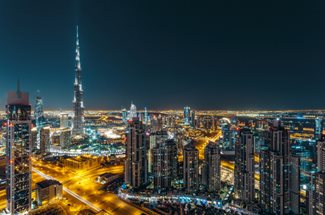
Hyperbole takes on a whole new meaning in Dubai. From a sleepy trading post, known primarily for the pearl trade until the 1930s, Dubai has morphed at warp speed from a regional center to a global city, a major transport hub, and is widely recognized as the financial center of the Middle East. While oil discoveries in the 1960s are primarily responsible for this dynamic growth, the emirate’s rulers, cognizant that these reserves will run out in the next two decades, have spearheaded an intense economic diversification into other sectors, including real estate. The past ten years have radically transformed the skyline of Dubai, thanks to giddy new heights of structural engineering achievement. Dubai's crowning glory is the iconic and record-breaking Burj Khalifa that, at 2722 feet, is currently the world’s tallest freestanding structure.
The breathtaking tower, which garnered rare and coveted "Global Icon" status, was designed by American architects from SOM (Skidmore, Owings and Merrill), the award-winning team behind One World Trade Center and the Willis Tower. Designer Adrian Smith took as his inspiration for the tower from a delicate desert flower known as the spider lily, whose slender petals or fronds radiate from a central bud. This created the tower's signature Y-shaped footprint, which is echoed in the decor and design of the interiors and resonates in the tower's logo. Smith also incorporated aspects of traditional Islamic architecture, including a nod to the region's spiral minarets in the tower's silhouette and the use of geometric patterns in the glass and reinforced concrete panels that make up the facade of the tower. The interior curves of the tower's hotel, residential suites, and corporate offices echo the elegant carving of Arabic script, used in Islamic architecture throughout the ages to decorate walls with sayings from the Koran.
The sheer scale of the Burj Khalifa is hard to absorb. On Dubai's frequent foggy mornings, the "sky lounges" of the tower’s upper floor seem to float above the clouds. The 10,000 people who typically frequent the tower on a daily basis are serviced by the world's fastest and longest double-deck elevators, which whisk them to the world's highest nightclub or world's highest library, or any of the tower's many fine dining establishments. Thrill-seekers are attracted to the Burj Khalifa like moths to spotlights: base jumping is popular, and the world watched, fascinated in 2011 as French climber Alain "Spiderman" Robert spent six hours scaling the tower from the base to the spire. Tom Cruise put his own stamp on the tower in the latest
Mission Impossible with gut-wrenching stunts on the tower's facade.
It’s hard to imagine what Dubai will come up with to top the Burj Khalifa, which has changed flight paths, broken some 18 world records, won countless awards, and created an entirely new interpretation of "the highest level of luxury." But until they do, the Burj Khalifa remains a potent symbol of just how far Dubai has come.
Experience the dizzying heights of Dubai on one of Alexander + Roberts popular itineraries to the region, such as
Spectacular Dubai, which perfectly balances guided excursions with plenty of free time to enjoy all that this exciting emirate has to offer!